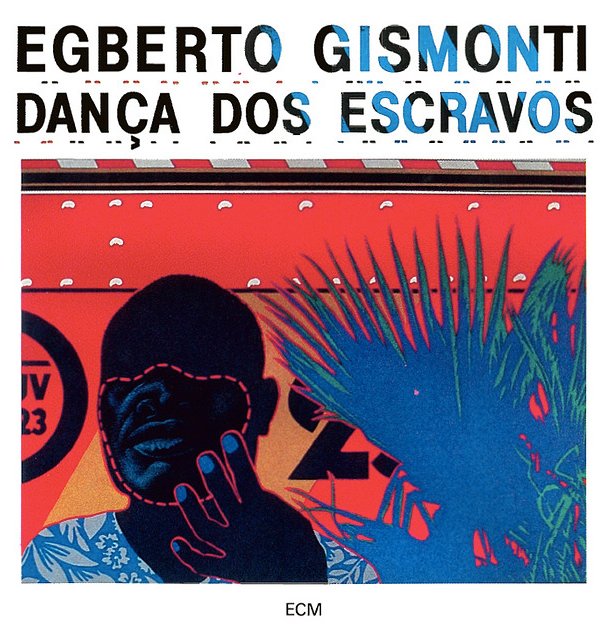Egberto Gismonti
Dança dos Escravos
Egberto Gismonti guitars
Recorded November 1988 at Rainbow Studio, Oslo
Engineer: Jan Erik Kongshaug
Produced by Manfred Eicher
When I first heard Egberto Gismonti’s Dança dos Escravos (Dance of the Slaves) it had been months since I’d listened to the Brazilian master, and the feeling of being wrapped in his brilliant passion again was a joy to say the least, for in his comforting embrace I can always find more than a gesture to relate to. Although he is an adept multi-instrumentalist, I’ve always felt that Gismonti excels alone at the guitar, and you will not likely find a purer distillation of his art than this. The 15-minute title track constitutes the album’s lungs, through which Gismonti respires in concise autobiographical detail. Upon waking, it hits the ground running, flipping space as if through the pages of a well-weathered book into which a photographic record has been pasted. The glue becomes brittle and flakes the farther one goes back, and though images have loosened their grip on the past Gismonti rescues them with every unexpected turn in his playing. There are moments when he seems to time-travel, his fingers working independently yet with an orchestral unity so personal that even when he adds a 12-string it seems but an extension of the same instrument.
“Dança dos Escravos” bears the subtitle “black,” and Gismonti has accordingly designated every track its own color. Red is represented by the enthralling opener, “2 Violões.” From jubilant to regretful, he cycles through a youth’s worth of faded dreams and unrequited loves. It is one of his best and in it we find the intimacies of his craft overflowing in full disclosure. Moving on to blue in “Lundu,” he plows through a cycle so engaging that he cannot help but let out an mm of ecstatic communion with his instrument. That same voice comes out more intentionally in the green (“Trenzinho do Caipira”) and in the white (“Salvador”), uncovering in both the playful spirit that lurks in the interstices of his memories. It is as if he were standing on the center of a seesaw, at one end of which is the weight of the future and at the other sits the child-self thereof. Gismonti pares his abstractions to their hearts, working them into the traditional yellow ornaments of “Alegrinho.” Here he shares a fleeting portrait of the streets (and of the trees not so far away). We encounter open markets and the patter of boys’ feet between stalls as they snatch fruits and life experience from the tables.
There is something indescribably authentic (whatever currency that word may have nowadays) about Gismonti’s music. Listen, for instance, to the burnished brown of “Memoria e Fado” and hear within it a thousand voices, each having fed into this one musical utterance and of which said utterance will one day become a part of the growing chorus to inspire those in the future. It is through this music that one steps outside into the night, looks up at the stars, and thinks not confoundedly, but rather forgoes philosophy, content in knowing that its mysteries are life itself. These are shadows made bright again.
<< Paul Giger: Chartres (ECM 1386 NS)
>> Ralph Towner: City Of Eyes (ECM 1388)



Terrific review. I heard a couple of tracks from this album on the radio today, and it made me stop what I was doing immediately and listen. Amazing playing, technique and spontaneity in perfect balance.
Thanks for stopping by, Tom. “Amazing playing, technique and spontaneity in perfect balance” captures this album to a T. One of those gems that reveals more with every listen.